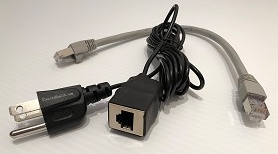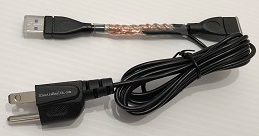Outlet on/off switch: Any device or appliance that is plugged in to an outlet will create electric field in the surrounding area even if the appliance is not running. Therefore, it is advisable to avoid unnecessary exposure to EMF by keeping devices unplugged when not in use. This outlet on/off switch makes it convenient.
The switch goes into the outlet, and your device goes into this switch. Then you can turn the outlet on/off as needed without having to unplug the device.
There are several versions of this switch. I found this particular one to be of good quality and reliability.
Remote outlet on/off switch: This switch allows you to turn an outlet on/off via a remote. This is especially useful if the outlet is in a hard-to-reach area. There is a button available also to turn it on/off without a remote (for outlets that are easily accessible, the manual on/off switch is still a good choice).
There are several models available. I recommend this one over the more popular BN-LINK model as it is more sturdy and higher amperage. Additionally, it allows two plugs to be attached.
Circuit Breaker Cutoff Switch

RCS4 Remote Cut Off Switch Kit: Cutting off power to the bedrooms by turning associated circuit breakers can significantly lower EMF when the body needs to rest. Using this RCS4 Remote Cut Off Switch Kit, one can do so remotely without making a trip to the breaker panel. It comes with 1 “Contactor” to control up to 4 circuits – they all turn on/off together with one button. Buy additional contactor (24 amp or 40 amp version) to control more circuits. You can have up to a total of 4 contractors, each one independently controlling a set of up to 4 circuits. The kit comes with 2 remotes. The range of the antenna can be increased using an additional 49-foot extender.
Use coupon code “YSL” for a 5% discount for this or any other products by Safe Living Technologies.
How to setup wired internet connection: If you want to turn off the WiFi option in your router and use wired connections for Internet access, thus protect your family from RF radiations, then this is how to do it: (a) Turn off the WiFi option in your router (b) buy an Ethernet switch like the TP-Link models mentioned here (c) Use a shielded Ethernet cable to connect the switch to the router (d) Use another Ethernet cable to connect your computer (or other device) to the Ethernet switch. (e) Optionally, ground the Ethernet switch. It is highly recommended in order to significantly lower EMF across the entire cable from the switch to your device. To do so, use a grounding adapter, such as the “Ethernet Grounding Adapter” recommended here.
TP-Link 16 Port Gigabit Ethernet Network Switch: This is used to setup hardwired internet connection as described above. This TP-link product is highly rated, and I have used for a long period of time without any issues. Its connectors are metal (as seen on the picture), allowing the unit to be grounded using a grounding adapter (see “Ethernet Grounding Adapter”).
If you need one with fewer ports, then you can use the 8-port model.
TP-Link 8 Port Gigabit Ethernet Network Switch: [See “How to setup wired internet connection” above] This has 8 ports only, but otherwise it is same as the TP-link 16-port model.
I recommend having one with a few additional ports than what you need. Between multiple computers, printers, iPads, etc., you can soon run out of ports.
Choosing Ethernet cables: Only shielded Ethernet cables should be used, which allows for grounding. Grounding is important as it significantly reduces EMF across the length of the cable. There are two good choices for shielded cables: (a) Cat 6a which allows 10 Gbps speed with a distance of up to 100 meters, and (b) Cat 8 is significantly faster which allows for 25/40 Gbps speed with a distance of up to 30 meters. So, Cat 8 has higher speed, but lower distance. It is more robust and has better shielding, which makes it more rigid and difficult to install in tight spaces. It also costs more.
For residential purposes, my opinion is that Cat 6a cables are sufficiently good. I do not recommend Cat 7 (not IEEE approved) or cables lower than 6a.
Cat 6a: 5 ft
Cat 6a: 10 ft
Cat 6a: 25 ft
Cat 6a: 50 ft
Cat 6a: 100 ft
Cat 8: 5 ft
Cat 8: 10 ft
Cat 8: 25 ft
Cat 8: 50 ft
Cat 8: 100 ft







